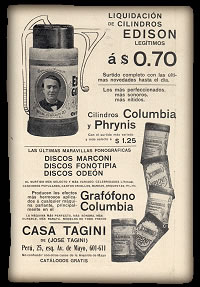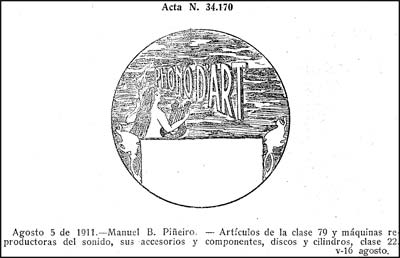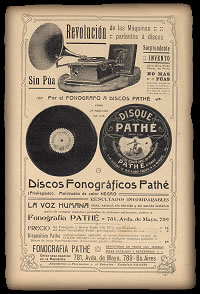By
A forgotten record label: Phono d’Art

n the period that goes from 1910 and 1915 the Argentine recording market experienced an interesting growth. It was by that time when many record trademarks appeared and the sales of gramophones increased by far. A great number of promotions were offered not only to the public, like uncountable raffles whose prizes were machines and records, but also to the entrepreneurs themselves who then had the chance to release discs by their own labels.
 This phenomenon was neither casual nor isolated: it was within the frame of a context of economic prosperity that the nation was living, and especially in the case of the record industry it was the consequence of the growing interest in the development of some musical forms and the compulsive need of buying novelties that, sometimes, was beyond the intrinsic quality of the product.
This phenomenon was neither casual nor isolated: it was within the frame of a context of economic prosperity that the nation was living, and especially in the case of the record industry it was the consequence of the growing interest in the development of some musical forms and the compulsive need of buying novelties that, sometimes, was beyond the intrinsic quality of the product.
Such period of bonanza would face a crisis a few years later because of World War I, but around the Centennial this concern was inexistent. The news about the far distant Italian-Turkish battles that the journals displayed in their pages did not spoil the local finances and even gave the chance to some shopkeepers to sell colored postcards, records about battles, military «reveries», etc. Absent-mindedly, Buenos Aires enjoyed the anodyne pleasures of its belle époque.
On a par with other outstanding manifestations of that time was the phonographic activity. A walk along the crowded Avenida de Mayo (then pride of the promenades) showed what was said above: on the corner with Perú was José Tagini’s shop, licensee of Columbia Record, Odeon and Fonotipia; on the opposite side of the street, Casa Lepage, run by Max Glücksmann, that sold Victor records; on 817, the Fonografía Pathé sold discs and machines with the «without stylus» system; a block further, on 925, a local run by Juan B. Tagini that also supplied discs and «talking machines» with the Columbia trademark.
 Far from being saturated, such a number of competitors satisfied a progressive demand. Another shop of this blossoming trade opened its doors on 821 Avenida de Mayo, with an entrance door also on 822 Rivadavia St.: The Inventions Company. This house was devoted to the sale of imported articles, such as the Maestropiano electric pianos and the Royal Standard typewriters. And among the most attractive items of its large catalog you would find the Phono d’Art improved gramophones, with or without horn, with cheap models which could be purchased from $ 12,50 up to the most sophisticated ones at $ 600 m/n (local currency).
Far from being saturated, such a number of competitors satisfied a progressive demand. Another shop of this blossoming trade opened its doors on 821 Avenida de Mayo, with an entrance door also on 822 Rivadavia St.: The Inventions Company. This house was devoted to the sale of imported articles, such as the Maestropiano electric pianos and the Royal Standard typewriters. And among the most attractive items of its large catalog you would find the Phono d’Art improved gramophones, with or without horn, with cheap models which could be purchased from $ 12,50 up to the most sophisticated ones at $ 600 m/n (local currency).
Towards the late 1910 The Inventions Company decided to add a record trademark of its own that matched these machines. For that purpose it used a loan granted by the Banco Mercantil del Río de la Plata. This bank, between 1910 and 1911 benefited several manufacturers and importers of discs like Juan y José Drysdale & Cía., Cassels & Co., Fonografía Pathé, Casa Lepage and others with loans to buy wares.
On December 27, 1910, under the number 31.906, there was an application filed in the record by Manuel B. Piñeiro for a design of the Phono d’Art record labels. Months later the same person filed an application again for a logotype on August 5, 1911 under the number 34.176.

These record labels were very attractive, with a great vignette that represented the muse Terpsichore watching the sea (a “woman with a lyre”) and below, in a yellow square, the information data of the recording written in red; the name Phono d’Art appeared above the perforation, with characters in perspective.
However, this company did not have its own recordings but under its label were released matrices of the serial 60.000 of Era records (owned by Jacuboff Hnos., even though for a time they were also distributed by The Inventions Company). In other words, there were no original recordings by Phono d’Art: its recordings were those timely made in Era.
 For this reason, under the Phono d’Art label discs of the Banda de Policía (conducted by Mtro. Rivara) and of the Rondalla del Gaucho Relámpago, among others, were sold with recordings that were simultaneously published by Era and by other satellite trademarks of Era, such as Artigas, Gayarre, Chantecler, Beka-Grand-Record, Parlophone Record, Scala-Record, Victoria-Record and others.
For this reason, under the Phono d’Art label discs of the Banda de Policía (conducted by Mtro. Rivara) and of the Rondalla del Gaucho Relámpago, among others, were sold with recordings that were simultaneously published by Era and by other satellite trademarks of Era, such as Artigas, Gayarre, Chantecler, Beka-Grand-Record, Parlophone Record, Scala-Record, Victoria-Record and others.
The Phono d’Art recordings had no record number but a side-matrix number. This means that on each side of the same record there were different numbers, but always within the serial 60.000. On the record labels this side-matrix number was placed at the bottom.
Its repertoire was, like most of the record companies at that time, miscellaneous. In it you would find some fashionable tangos, waltzes, mazurkas and other dances; the estilo “La tapera” was side by side with Pietro Mascagni’s “Cavalleria Rusticana”, and folk-like comic speeches were offered along with scenes of Verdi’s “Un Ballo in Maschera”.
It did not last long. Some time later, The Inventions Company stopped its phonographic activity and the Phono d’Art discs were finally sold at bargain sales. Little by little the technical improvements and the fluctuations of fashion were surmounting them and by 1915 nobody remembered them. All the attention of the people of Buenos Aires was now drawn to the news from Europe.